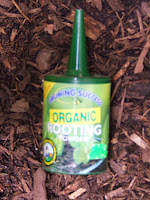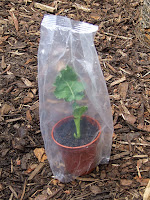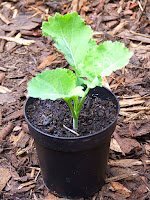Yesterday I brought home cuttings material to start off a new batch of green and variegated Daubenton kale plants. Plants from the existing batches are being sent out to people on a waiting list as they become established but I'm looking forward to having some 'buy it now' plants available on my website. For anyone wondering how to multiply their own plants I describe below how I do it.
This is Daubenton kale. It's a perennial kale that forms an attractive mound of mild and nutty-flavoured leaves which are available all year around. The plant is usually propagated by cuttings. It rarely flowers and even then usually produces only a few flowering shoots which may or may not set seed.
Daubenton kale was first described by the French naturalist Louis Jean-Marie Daubenton - or D'Aubenton - (1716 – 1800). Daubenton, who was responsible for introducing Merino sheep from Spain into France, wrote, "Instruction pour les bergers et pour les proprietaires de troupeaux" ("Advice to shepherds and owners of flocks") and it was in this book in 1782 that he first describes 'choux de bouture' (cuttings cabbage):
It is a variety in the species of cabbage, unknown to botanists ; it was cultivated in small gardens, in the commune of Montbard; it throws out lateral branches, the lowest of which bend quite to the earth, while the rest of the growth is directed upwards: — the part, which touches the earth, takes root, and produces new cabbages, which are perpetuated from year to year, and which form so gross a mass, that it is necessary to destroy a part of it. It is called choux de bouture, because it is planted in this manner without sowing ; its branches are broken off and given to sheep : it does not head, but produces a great many leaves, when it grows in a good soil, well dunged.
In a latter edition he elaborates:
It is difficult to have a fairly large amount of cabbage for the numerous flocks: one must sow, transplant, watering for several days, and this care must be repeated annually; it would be too time-consuming and expensive for farmers. I would not consider that cabbage was of any advantage for the diet of flocks, had I not met a variety of cabbage that one can have without sowing, transplanting or watering, it is also unknown to naturalists and farmers: it resists frost, like kale and collards, and is better for their livestock because its cultivation is very easy. One can multiply by cuttings; just cut its lateral branches, which are in large numbers and put them in the ground, to soon have a whole field of new plants. The leaves are smaller than other cabbages; but their juice is also abundant; they may serve as food for the shepherds as well as the sheep;.....
See note below.
Here is "le chou Daubenton panaché", variegated Daubenton kale. I believe panaché is simply French for 'variegated' but I think this plant also has panache!
I haven't been able to trace its history. I've often wondered how closely related it is to Daubenton kale as its leaf shape seems a little different. I haven't had mine long but so far it does seems to have a similar growth habit and a similar taste.
This is how I do Daubenton cuttings. There are other ways: woodier stem portions without leaves will root when pushed into the ground and I'm told that root cuttings work well for brassicas also.
Take a leafy side shoot.
Cuttings taken with a heel may root more quickly....
(...but as I'm trying to make plants of a suitable size to send in the post I usually shorten the cutting). Removing most of the leaves helps the cutting retain moisture whilst it is establishing roots.
One prepared cutting.
Rooting hormone may help but is not necessary.
Insert the cutting in a pot of compost (I use a general purpose peat-free compost).
Cover the pot with a ventilated plastic bag. (As I usually propagate kale in batches of pots I place the pots in a tray and use a plastic tray cover.) Ventilate the bag more - or remove it altogether - if you notice mildew growing on the cutting.
Don't worry if at first older leaves wilt, yellow and drop.
When the roots start to grow the leaves turn a brighter shade of green.
The cutting is ready to plant out when roots start to emerge from the bottom of the pot.
Daubenton kale growing in a half-barrel in a semi-shaded situation.
N.B. [In later editions of the book there are notes added by other botanists to the effect that propagation by cuttings is not unique to Daubenton's kale (most brassicas can be propagated in this way).
Before delving into the history of Daubenton kale I'd been assuming that it is perennial because it rarely flowers (so instead of setting seed and then dying it just keeps leafing up year after year). But it is the way that it flops to the ground and roots by itself that seems to earn it the description of 'vivace' (perennial) in the nineteenth century (it is not unique in this either but rather belongs to a group of branching bush kales, Brassica oleracea ramosa, cultivated since antiquity).
I've read recently that, because of accumulated mutations, plants tend to lose their ability to reproduce by seed if they are propagated vegetatively for a long period. So does Daubenton kale need to be reproduced by cuttings because it rarely flowers or does it rarely flower because it is reproduced by cuttings?! Perhaps its perennial nature may not be greater than that lurking in the genetic make up of many flowering brassicas - except in its 'flop and root' tendencies. Anyway I will make sure I don't stake my allotment plants in future.]
N.B. I sell a range of perennial vegetable plants on my website. 












